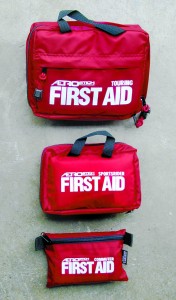There’s no guarantee that having a motorcycle first-aid kit will prevent you from having an accident any more than taking a rainsuit along on a ride will guarantee dry weather. But like a rainsuit when the clouds open up, there’s no substitute for a good first-aid kit when disaster strikes. Aerostich offers a trio of kits tailored to riders, each one aimed at a different segment of the motorcycling population, from commuters to sport riders to tourers.
The Aerostich Touring First-Aid kit is the most complete, as well as the physically largest, measuring 8.5 x 6 x 5.5 inches and weighing in at 1 pound, 8 ounces. It contains a copy of the Comprehensive Guide to Wilderness and Travel Medicine, and the Illustrated Guide to Life-Threatening Emergencies, both by Dr. Eric A. Weiss, MD; a non-mercury thermometer; EMT shears and bandage scissors; several doses of Tylenol, Motrin and aspirin; a small roll of duct tape; and supplies to deal with various types of injuries and emergencies, including CPR and bleeding (a CPR shield, nitrile examination gloves, trauma pads and antimicrobial hand wipes), burns and blisters (moleskin, adhesive knit, antibiotic ointment), fractures and sprains (elastic bandage), and wound care (an irrigation syringe, iodine, wound closure strips, sterile dressing and gauze pads, adhesive tape and knuckle bandages).
The Sport first-aid kit lacks some of the Touring kit’s components, such as the CPR shield and the thermometer, but at 6.5 x 4.5 x 2.25 inches and 15 ounces it’s easy to fit into a tankbag and therefore more likely to be carried regularly. The Commuter kit is the smallest yet, about the size and weight of a paperback book, and has the most rudimentary selection of components. It also lacks the Comprehensive Guide, which is a potential lifesaver all by itself, as well as a source of interesting and slightly macabre advice, as in the section on lightning strikes: “Rather than adhere to the standard rescue dogma of ignoring the victims who appear deadÉafter a lightning strike, treat those victims first who appear dead, because they ultimately may recover if quickly given mouth-to-mouth and CPR.”

All three kits come in sturdy zippered nylon cases that include plastic or nylon loops so you can attach them to your belt or secure them inside your luggage so you’ll know exactly where they are when you need them. The Touring and Sport kits have interior mesh and see-through pockets so there’s no fumbling for the thing you’re looking for.
I’ve carried a Touring kit on my bike for years, and I’m happy to say I’ve never had to use it. Lately, though, when I was preparing for a ride, I went through it to re-familiarize myself with its contents and discovered that many of the components, like the painkillers and the antibiotic ointments, had gone out of date. Most appeared to have been packaged in small or individual doses specifically to fit in first-aid kits, and were not available at my local drug store. I contacted Aerostich’s Andy Goldfine about the problem, and he said he’s looking into assembling “refill kits” containing all the perishable items. Until then, the solution is to replenish out-of-date items on my own.
The Touring, Sport and Commuter first-aid kits from Aerostich retail for $55, $42 and $20, respectively. If you have the room on your bike or in your saddlebag, I’d recommend the Touring kit. If you don’t have that much room, at least make some for one of these other kits. Someday you or a riding buddy might be glad you did.
For more information contact Aerostich Riderwearhouse, 8 South 18th Avenue West, Duluth, Minnesota 55806; (800) 222-1994; www.aerostich.com








[…] a mobile phone, and power pack, as well as some basic first aid supplies like the ones detailed at ridermagazine.com […]